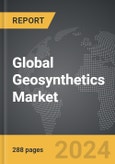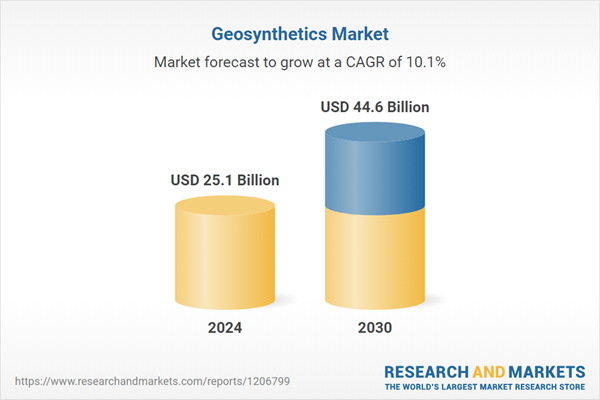The global market for Geosynthetics was valued at US$25.1 Billion in 2024 and is projected to reach US$44.6 Billion by 2030, growing at a CAGR of 10.1% from 2024 to 2030. This comprehensive report provides an in-depth analysis of market trends, drivers, and forecasts, helping you make informed business decisions. The report includes the most recent global tariff developments and how they impact the Geosynthetics market.
Technological advancements in geosynthetics have significantly improved their performance and broadened their application scope. Innovations in polymer chemistry have led to the development of geosynthetics with enhanced strength, durability, and resistance to environmental degradation. For instance, the incorporation of UV stabilizers and antioxidants in geotextiles and geomembranes has improved their longevity when exposed to harsh environmental conditions. Additionally, advancements in manufacturing techniques, such as weaving, knitting, and extrusion, have resulted in geosynthetics with superior mechanical properties and functionality. The integration of smart technologies, such as sensors and monitoring systems embedded within geosynthetics, is also emerging, enabling real-time monitoring of structural health and performance. These technological advancements are driving the adoption of geosynthetics in increasingly complex and large-scale projects, from highways and railways to coastal protection and mining operations.
The growth in the geosynthetics market is driven by several factors, including increasing infrastructure development, environmental protection regulations, and advancements in material science. The surge in construction activities, particularly in emerging economies, is boosting the demand for geosynthetics in applications such as road construction, embankments, and erosion control. Environmental regulations aimed at protecting natural resources and mitigating the impact of industrial activities are also promoting the use of geosynthetics in waste management, water containment, and soil remediation projects. Technological advancements in polymer materials and manufacturing processes are enhancing the performance and cost-effectiveness of geosynthetics, making them more attractive to engineers and project managers. Additionally, the growing awareness of the long-term benefits of geosynthetics, such as their ability to reduce maintenance costs and extend the lifespan of infrastructure, is further propelling market growth. As a result, the geosynthetics market is poised for significant expansion, supported by a combination of economic, regulatory, and technological factors that underscore the critical role of these materials in modern engineering and environmental management.
Segments: Product Type (Geotextiles, Geomembranes, Geogrids, Other Product Types); Application (Water / Wastewater Management, Transportation Infrastructure, Civil Construction & Mining, Energy, Other Applications).
Geographic Regions/Countries: World; United States; Canada; Japan; China; Europe (France; Germany; Italy; United Kingdom; Spain; Russia; and Rest of Europe); Asia-Pacific (Australia; India; South Korea; and Rest of Asia-Pacific); Latin America (Argentina; Brazil; Mexico; and Rest of Latin America); Middle East (Iran; Israel; Saudi Arabia; United Arab Emirates; and Rest of Middle East); and Africa.
The analysts continuously track trade developments worldwide, drawing insights from leading global economists and over 200 industry and policy institutions, including think tanks, trade organizations, and national economic advisory bodies. This intelligence is integrated into forecasting models to provide timely, data-driven analysis of emerging risks and opportunities.
Geosynthetics - Key Trends and Drivers
Geosynthetics are synthetic materials used in civil engineering and environmental projects to enhance soil stability, provide erosion control, and improve drainage. These materials include geotextiles, geomembranes, geogrids, geonets, and geocomposites, each serving specific functions depending on the application. Geotextiles, for example, are permeable fabrics used to separate, filter, reinforce, protect, or drain soil. Geomembranes, on the other hand, are impermeable membranes used primarily for containment and environmental protection, such as in landfill liners and pond liners. Geogrids are utilized for soil reinforcement in retaining walls and subgrade stabilization. The versatility and durability of geosynthetics make them indispensable in modern construction and environmental management, offering cost-effective solutions that extend the life and functionality of infrastructure projects.Technological advancements in geosynthetics have significantly improved their performance and broadened their application scope. Innovations in polymer chemistry have led to the development of geosynthetics with enhanced strength, durability, and resistance to environmental degradation. For instance, the incorporation of UV stabilizers and antioxidants in geotextiles and geomembranes has improved their longevity when exposed to harsh environmental conditions. Additionally, advancements in manufacturing techniques, such as weaving, knitting, and extrusion, have resulted in geosynthetics with superior mechanical properties and functionality. The integration of smart technologies, such as sensors and monitoring systems embedded within geosynthetics, is also emerging, enabling real-time monitoring of structural health and performance. These technological advancements are driving the adoption of geosynthetics in increasingly complex and large-scale projects, from highways and railways to coastal protection and mining operations.
The growth in the geosynthetics market is driven by several factors, including increasing infrastructure development, environmental protection regulations, and advancements in material science. The surge in construction activities, particularly in emerging economies, is boosting the demand for geosynthetics in applications such as road construction, embankments, and erosion control. Environmental regulations aimed at protecting natural resources and mitigating the impact of industrial activities are also promoting the use of geosynthetics in waste management, water containment, and soil remediation projects. Technological advancements in polymer materials and manufacturing processes are enhancing the performance and cost-effectiveness of geosynthetics, making them more attractive to engineers and project managers. Additionally, the growing awareness of the long-term benefits of geosynthetics, such as their ability to reduce maintenance costs and extend the lifespan of infrastructure, is further propelling market growth. As a result, the geosynthetics market is poised for significant expansion, supported by a combination of economic, regulatory, and technological factors that underscore the critical role of these materials in modern engineering and environmental management.
Report Scope
The report analyzes the Geosynthetics market, presented in terms of units. The analysis covers the key segments and geographic regions outlined below.Segments: Product Type (Geotextiles, Geomembranes, Geogrids, Other Product Types); Application (Water / Wastewater Management, Transportation Infrastructure, Civil Construction & Mining, Energy, Other Applications).
Geographic Regions/Countries: World; United States; Canada; Japan; China; Europe (France; Germany; Italy; United Kingdom; Spain; Russia; and Rest of Europe); Asia-Pacific (Australia; India; South Korea; and Rest of Asia-Pacific); Latin America (Argentina; Brazil; Mexico; and Rest of Latin America); Middle East (Iran; Israel; Saudi Arabia; United Arab Emirates; and Rest of Middle East); and Africa.
Key Insights:
- Market Growth: Understand the significant growth trajectory of the Geotextiles segment, which is expected to reach US$19.8 Billion by 2030 with a CAGR of a 9.4%. The Geomembranes segment is also set to grow at 10.6% CAGR over the analysis period.
- Regional Analysis: Gain insights into the U.S. market, valued at $6.5 Billion in 2024, and China, forecasted to grow at an impressive 13.4% CAGR to reach $10.2 Billion by 2030. Discover growth trends in other key regions, including Japan, Canada, Germany, and the Asia-Pacific.
Why You Should Buy This Report:
- Detailed Market Analysis: Access a thorough analysis of the Global Geosynthetics Market, covering all major geographic regions and market segments.
- Competitive Insights: Get an overview of the competitive landscape, including the market presence of major players across different geographies.
- Future Trends and Drivers: Understand the key trends and drivers shaping the future of the Global Geosynthetics Market.
- Actionable Insights: Benefit from actionable insights that can help you identify new revenue opportunities and make strategic business decisions.
Key Questions Answered:
- How is the Global Geosynthetics Market expected to evolve by 2030?
- What are the main drivers and restraints affecting the market?
- Which market segments will grow the most over the forecast period?
- How will market shares for different regions and segments change by 2030?
- Who are the leading players in the market, and what are their prospects?
Report Features:
- Comprehensive Market Data: Independent analysis of annual sales and market forecasts in US$ Million from 2024 to 2030.
- In-Depth Regional Analysis: Detailed insights into key markets, including the U.S., China, Japan, Canada, Europe, Asia-Pacific, Latin America, Middle East, and Africa.
- Company Profiles: Coverage of players such as AGRU America, Inc., Berry Global, Inc., CETCO, Fibertex Nonwovens A/S, GSE Environmental, Inc. and more.
- Complimentary Updates: Receive free report updates for one year to keep you informed of the latest market developments.
Some of the 72 companies featured in this Geosynthetics market report include:
- AGRU America, Inc.
- Berry Global, Inc.
- CETCO
- Fibertex Nonwovens A/S
- GSE Environmental, Inc.
- Hanes Geo Components
- Low & Bonar PLC
- Mattex Geosynthetics
- NAUE GmbH & Co. KG
- Officine Maccaferri SPA
- Propex Operating Company, LLC
- Raven Industries, Inc.
- Tenax Corporation
- TenCate Geosynthetics Americas
- Tensar International Corporation, Inc.
- Thrace-LINQ, Inc.
Tariff Impact Analysis: Key Insights for 2025
Global tariff negotiations across 180+ countries are reshaping supply chains, costs, and competitiveness. This report reflects the latest developments as of April 2025 and incorporates forward-looking insights into the market outlook.The analysts continuously track trade developments worldwide, drawing insights from leading global economists and over 200 industry and policy institutions, including think tanks, trade organizations, and national economic advisory bodies. This intelligence is integrated into forecasting models to provide timely, data-driven analysis of emerging risks and opportunities.
What’s Included in This Edition:
- Tariff-adjusted market forecasts by region and segment
- Analysis of cost and supply chain implications by sourcing and trade exposure
- Strategic insights into geographic shifts
Buyers receive a free July 2025 update with:
- Finalized tariff impacts and new trade agreement effects
- Updated projections reflecting global sourcing and cost shifts
- Expanded country-specific coverage across the industry
Table of Contents
I. METHODOLOGYII. EXECUTIVE SUMMARY2. FOCUS ON SELECT PLAYERSIII. MARKET ANALYSISCANADAITALYSPAINRUSSIAREST OF EUROPESOUTH KOREAREST OF ASIA-PACIFICARGENTINABRAZILMEXICOREST OF LATIN AMERICAIRANISRAELSAUDI ARABIAUNITED ARAB EMIRATESREST OF MIDDLE EASTIV. COMPETITION
1. MARKET OVERVIEW
3. MARKET TRENDS & DRIVERS
4. GLOBAL MARKET PERSPECTIVE
UNITED STATES
JAPAN
CHINA
EUROPE
FRANCE
GERMANY
UNITED KINGDOM
ASIA-PACIFIC
AUSTRALIA
INDIA
LATIN AMERICA
MIDDLE EAST
AFRICA
Companies Mentioned (Partial List)
A selection of companies mentioned in this report includes, but is not limited to:
- AGRU America, Inc.
- Berry Global, Inc.
- CETCO
- Fibertex Nonwovens A/S
- GSE Environmental, Inc.
- Hanes Geo Components
- Low & Bonar PLC
- Mattex Geosynthetics
- NAUE GmbH & Co. KG
- Officine Maccaferri SPA
- Propex Operating Company, LLC
- Raven Industries, Inc.
- Tenax Corporation
- TenCate Geosynthetics Americas
- Tensar International Corporation, Inc.
- Thrace-LINQ, Inc.
Table Information
| Report Attribute | Details |
|---|---|
| No. of Pages | 288 |
| Published | April 2025 |
| Forecast Period | 2024 - 2030 |
| Estimated Market Value ( USD | $ 25.1 Billion |
| Forecasted Market Value ( USD | $ 44.6 Billion |
| Compound Annual Growth Rate | 10.1% |
| Regions Covered | Global |









